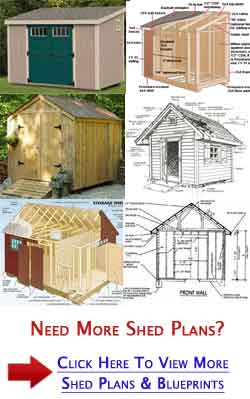
 monroesheddepot.com
monroesheddepot.com Introduction: Building Your Own Backyard Shed
Building your own shed can be a rewarding and cost-effective way to add storage space or a workshop to your property. This guide will walk you through the essential steps for constructing a simple, sturdy shed from scratch.
Planning and Preparation:
Permits and Regulations: First, check with your local municipality about building permits and zoning regulations. This will prevent legal issues down the road. Design and Dimensions: Decide on the size and design of your shed. Consider what you'll be storing and how much space you need. Sketch out your design and create a detailed materials list. Free shed plans are available online or you can purchase detailed blueprints. Materials Acquisition: Source your lumber, roofing materials, siding, fasteners, and any other necessary components. Pressure-treated lumber is essential for the base and framing near the ground to prevent rot. Tools and Equipment: Gather all the tools you'll need, including a level, square, measuring tape, saw (circular saw or miter saw), drill, hammer, safety glasses, work gloves, and possibly a nail gun. Step 1: Building the Foundation
Site Preparation: Clear the area where the shed will be built. Remove any vegetation, rocks, or debris. Level the ground as much as possible. Gravel Base (Optional): A gravel base provides drainage and prevents moisture from wicking into the shed. Spread a layer of gravel (4-6 inches deep) and compact it. Foundation Options: Concrete Slab: Pour a concrete slab for a permanent, level foundation. This requires more work but offers the most stability. Gravel Pad with Concrete Blocks: Place concrete blocks on the leveled gravel pad to create a level base for the floor frame. Ensure the blocks are evenly spaced and level with each other. Wooden Skid Foundation: Build a frame using pressure-treated lumber. Place the frame directly on the leveled gravel base. This is the easiest and most portable option. Leveling: Regardless of your chosen foundation, use a level to ensure the base is perfectly level before proceeding. This is crucial for a structurally sound shed. Step 2: Constructing the Floor Frame
Frame Assembly: Cut pressure-treated lumber to the dimensions of your shed's floor. Assemble the frame using screws or nails designed for exterior use. Adding Joists: Install floor joists inside the frame at regular intervals (usually 16 inches on center). These provide support for the flooring. Fastening: Securely fasten the joists to the frame using screws or nails. Ensure the joints are square and strong. Laying the Subfloor: Cut plywood or OSB to fit the floor frame. Screw or nail the subfloor to the joists. Step 3: Framing the Walls
Cutting Wall Studs: Cut the wall studs to the desired height. Consider the height of the door and any windows. Assembling Wall Frames: Build each wall frame by attaching the studs to top and bottom plates (horizontal pieces of lumber). Space the studs at regular intervals (usually 16 inches on center). Frame openings for doors and windows, adding headers above the openings for support. Raising the Walls: With help from another person, raise each wall frame and position it on the floor frame. Securing the Walls: Secure the walls to the floor frame and to each other at the corners using screws or nails. Use a level to ensure the walls are plumb (vertical). Temporary Bracing: Add temporary bracing to the walls to keep them in place while you work on the roof. Step 4: Building the Roof
Rafters or Trusses: Choose between building rafters or using pre-fabricated roof trusses. Trusses are easier to install but rafters allow for more customization. Installing Rafters: Cut the rafters to the correct length and angle. Attach them to the top plates of the walls, ensuring they are evenly spaced. Use rafter ties to connect the rafters to each other at the peak. Installing Trusses: Lift and position the roof trusses onto the walls, spacing them evenly. Secure them to the walls with screws or nails. Sheathing the Roof: Cover the rafters or trusses with plywood or OSB sheathing. Secure the sheathing with screws or nails. Underlayment: Install roofing underlayment (felt paper or synthetic underlayment) to protect the sheathing from moisture. Step 5: Installing Siding and Roofing
Siding Installation: Install the siding of your choice (wood, vinyl, metal) according to the manufacturer's instructions. Overlap the siding properly to prevent water penetration. Roofing Installation: Install the roofing material (shingles, metal roofing, etc.) according to the manufacturer's instructions. Start at the bottom and work your way up, overlapping each course. Step 6: Installing Doors and Windows
Door Installation: Install the door in the framed opening, ensuring it is plumb and square. Secure it with screws. Install the door hardware (knob, lock, hinges). Window Installation: Install the windows in the framed openings, ensuring they are level and sealed properly. Use caulk to seal around the edges. Step 7: Finishing Touches
Trim: Install trim around the doors, windows, and corners to give the shed a finished look. Painting or Staining: Paint or stain the shed to protect the wood and enhance its appearance. Ventilation: Install vents to allow for air circulation and prevent moisture buildup. Shelving and Organization: Add shelving, hooks, or other organizational features to maximize the storage space inside the shed. Conclusion: Enjoying Your New Shed
Congratulations, you've built your own shed! Now you can enjoy the extra storage space or workshop you've created. Remember to maintain your shed regularly to keep it in good condition for years to come. This involves checking for leaks, repainting or restaining as needed, and ensuring proper ventilation.
8x8 Standard Shed
 monroesheddepot.com
monroesheddepot.com Cedar Lap Siding Saltbox Sheds
 www.gazebocreations.com
www.gazebocreations.com Cedar Lap Siding Deluxe Estate Sheds
 www.gazebocreations.com
www.gazebocreations.com



 monroesheddepot.com
monroesheddepot.com  monroesheddepot.com
monroesheddepot.com  www.gazebocreations.com
www.gazebocreations.com  www.gazebocreations.com
www.gazebocreations.com



0 komentar:
Posting Komentar